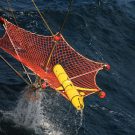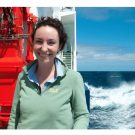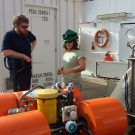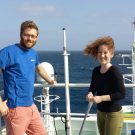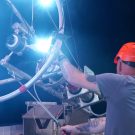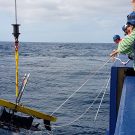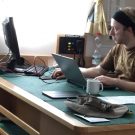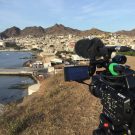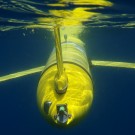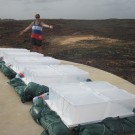*** English version below *** Wenn man das Wort Eddy hört, ist die erste Assoziation der Meisten ein Name, ein Kumpel, oder vielleicht sogar ein Musiker. Wie z.B. der Name des legendäre Bassisten Eddie Gomez oder des berühmte Jazzpianisten Eddy Louis. Wenn man in den Meereswissenschaften über einen Eddy spricht, ist das eine ganz andere […]
MSM61: Ein Perspektivenwechsel – Changing the perspective
*** English version below *** Seit drei Jahren arbeite ich für die Organisation for Economic Co-operation and Development (OECD), deren Ziel es ist für die Regierungen seiner derzeit 35 Mitgliedsländer evidenz-basierte Politikempfehlungen zu formulieren. Ich selbst habe mich mit dem Thema Meereswirtschaft beschäftigt und dabei ökonomische Wachstumsprognosen für einzelne maritime Industrien sowie die Meereswirtschaft gesamtheitlich […]
MSM61: Wie die Meerestiefen verbunden sind – Connecting the oceans’ depths
Hast du dich auch schon einmal gefragt, wie sich Muscheln und kleine Rankenfußkrebse an einer Boje mitten im Ozean festsetzen? Wie sind sie dahin gekommen? Wo kommen sie her? Sind sie geschwommen? Wie lang brauchten sie? Jetzt denk an all die Lebewesen, die in tausenden Metern Tiefe den Boden der Tiefsee bevölkern. Rankenfußkrebse und viele […]
MSM61: „Wenn jemand eine Reise tut, so kann er viel erzählen…!” – “If you take a trip, you have much to tell…!“ Zitat: Matthias Claudius
Und das kann ich, Lisa-Marie, die Schülerin aus Schleswig-Holstein, und Mitglied des Freitags-Forscher-Club am GEOMAR Helmholtz Institut für Ozeanforschung Kiel von der Forschungsfahrt MSM61 auf der MARIA S. MERIAN besonders viel. Wahnsinnig spannend, aufregend und ein bisschen anstrengend – so in etwa würde ich meine erste Forschungsfahrt mit wenigen Worten beschreiben. Ich habe das große […]
MSM61: Dive into the deep
*** Deutsche Version weiter unten *** The deep sea is the largest environment on the planet. Most of the deep sea consists of the water column above the seafloor, the pelagic zone. In many parts of the pelagic ocean, no scientific sample or observation has ever been collected. Consequently, knowledge on deep-sea pelagic biodiversity and […]
MSM61: Mit Wellenenergie durch den Atlantik – Wave powered journey through the Atlantic
*** english version below *** Ein Ansatz zur Reduktion von räumlicher und zeitlicher Variabilität ozeanographischer Messungen ist die Einbeziehung von autonomen Fahrzeugen als Erweiterung der klassischen Schiffs-gebundenen Untersuchungen. Die Einsatzdauer dieser Fahrzeuge ermöglicht eine andauernde Anwesenheit im Einsatzgebiet und somit eine hoher Messdatendichte. Heute erfolgte im Rahmen der Forschungsseereise MSM61 das Aussetzen zweier autonomer Oberflächenfahrzeuge vom […]
MSM61: Eine Seefahrt, die ist lustig, …
**** english version below **** … eine Seefahrt, die ist schön,… so beginnt ein altes Volkslied und in der Tat: Zur See fahren hat schon seinen ganz besonderen Reiz. Mich als Wissenschaftler fasziniert der offene Ozean immer wieder aufs Neue. Ich halte mich jetzt mal mit Beschreibungen hierzu zurück, da man den Ozean einfach auf […]
MSM61: Internationale Zusammenarbeit und Start der Expedition MSM61 in Mindelo
(English version below) 2017 ist ein ganz besonderes Jahr für die Deutsch-Kapverdische Zusammenarbeit zwischen dem GEOMAR und dem Instituto Nacional de Desenvolvimento das Pescas (INDP). In Mindelo soll dieses Jahr das Ocean Science Centre Mindelo (OSCM) eröffnet werden. Die Kapverdischen Inseln sind schon lange ein wichtiger Standort für die Forschung und durch die enge Kooperation […]
Glider survey started…
Right after New Year’s Day a team of GEOMAR and INDP scientists and technicians have successfully deployed a pair of two oceanographic SLOCUM gliders. The two gliders were prepared on land at INDP and later deployed from RV Islandia south of the island of Santo Antao. The two gliders are equipped with a suite of […]
Collecting Saharan dust at Cape Verde
„Why the hell do you go to Cape Verde to collect Saharan dust??“ was the question that Mirja was confronted with several times by the locals at Cape Verde in October. Of course it would be much easier to collect the sand straight from the Sahara desert in one day instead of mounting boxes on […]
